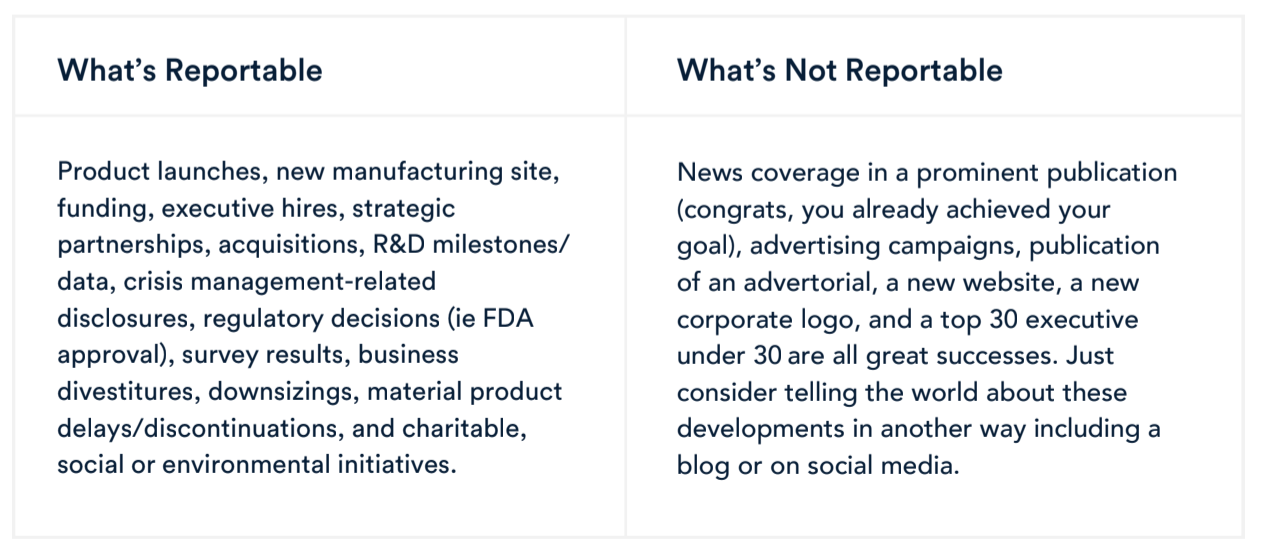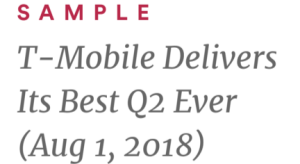Number 1 — Your news needs to be Reportable.
First; decide if your news is newsworthy. You have something to announce. if and only if you can answer yes to all three of the following:
- Will you announce something that’s never been made public anywhere?
- Will audiences outside your organization like customers, investors, industry peers, or the local community give a hoot?
- Have you ever read an article in a news outlet of any kind about similar development of comparable magnitude (be honest with yourself)?
If you answered no to any of these questions, don’t worry — you most likely have something that is worth telling the world but in a blog, on social media, or a newsletter. Ignoring this advice will only frustrate reporters, forever banishing you to their spam folder.

Number 2 — Nail the Headline.
This is a great headline. It’s short, impactful and memorable.
Without a strong headline, reporters will ignore your release. Effective headlines must have the following:
- Be a succinct sentence that describes who is making the announcement, what is being announced, and why anyone should care.
- Exclude jargon and hyperbole.
- Include a media hook. This is an angle for reporters, not a sales pitch on your company or product.

This is a great headline. It’s short, impactful and memorable.
Number 3 — Stand-Alone First Paragraph
Your first paragraph is prime real estate. Few eyeballs read further. In as few words possible, explain to reporters, investors and customers why they should care. This is not the time for self-adulation, rather your opportunity to give audiences what they want: Reporters? On deadline to post a story that gets clicks. Investors? Must decide to buy, sell or hold. Customers?
Want to know how something improves their business or lives.
Number 4 — Add Visuals

The above image was included in a release and used by The Telegraph among other trade outlets. The agency behind this campaign, Trier and Co., was able to generate stories that reinforced their client’s brand.
Images sell news. Nearly every online article today includes a photo, graphic or video. Give reporters what they need to get clicks to their stories. By not including an image you run the risk the reporter finds their own. Think off-the-mark stock image, or worse, an image from your competitor. Examples include customers using your product, employees at work, an infographic, or anything else about your business or news that is visually interesting. Since you’ll want to share your news on social, create a landscape version that abides by these image size guidelines.
Number 5— Key Takeaways (or Subhead)
Create a list of key takeaways so that reporters, investors and customers can quickly decide if your news is relevant to their news beat, portfolio, or consumer interests. This practice is becoming common, which you’ll see at the of news articles from major publications and likewise should be adopted for news releases. Ideally, you’re taking advantage of a functionally stylized and/or multimedia news release that lets you place these
Number 6 — Don’t Waste Quotes
Reporters are often too time-strapped to interview a company and will pull quotes from a release. Knowing this, quotes must be media-ready and conversational. Avoid jargon words like “disruptive,” use active tense, keep it short and please, don’t pat yourself on the back with phrases like “we are thrilled” that take up space, state the obvious and cause most readers eyes’ to look for the next paragraph.

Again, here’s T-Mobile’s communications team crushing it with best practice.
Number 7 — Quality Over Quantity
Your news release has to tell your story in 90 seconds or less. Keep the body of your release to a minimum. Include only what’s essential, don’t be redundant, use as few adjectives as possible, and avoid industry jargon and business lingo. We get how easy it is to let industry jargon creep into a release (hey, we’re guilty of it ourselves). Just recognize it when it happens and fix it with plain words.
Some terms to avoid include:
- Aligned
- Disruptive
- Econsystem
- Leverage
- Maximize
- Paradigm
- Platform
- Robust
- Scalable
- Value add
- Viral (unless your announcing a flu cure)
- You gt the point, no need to be more ‘granular’
Number 8 — Keep it Simple
Use language that can be understood by as many people as possible. You won’t win points showing how smart you are. For technical industries, there are times when it’s okay to incorporate complex or scientific information (research data, technical specs, etc.). Just don’t include this information at the top of the release. The bottom line is don’t make your readers work to understand what you are saying.
Number 9 — Boiler Plate
Your boilerplate functions as your company summary and should be at the bottom of all your news releases to help reporters to get basic company information that they can add as context. Write two to three sentences that explains in simple terms who you are, what you do, and how you help your customers and/or investors.

